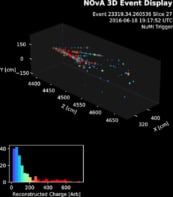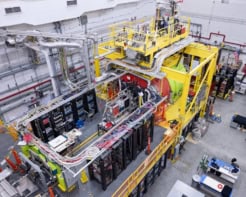
By Hamish Johnston
This stylish chap is looking for an incredibly rare nuclear process called neutrinoless double beta decay. The picture was taken deep under a mountain at Italy’s Gran Sasso National Laboratory, which is about 160 km north-west of Rome. He is standing in a cavern containing the GERDA experiment, which has been searching for the rare decay since 2011.
GERDA hasn’t actually detected a decay event, but the collaboration claims to have measured the best value yet of the lower limit on its half-life in germanium-76. They researchers say that it’s about 2.1 × 1025 years – or 21 yottayears!
Neutrinoless double beta decay occurs when two neutrons in a nucleus transform into two protons and two electrons. “Neutrinoless” is used to distinguish the process from double beta decay, in which two electron antineutrinos are produced in addition to the protons and electrons. Double beta decay is also extremely rare, having a half-life of about 2 × 1021 years in germanium-76.
Actually seeing neutrinoless double beta decay would provide important information about neutrinos and point to physics beyond the Standard Model. Its observation would imply that neutrinos are Majorana particles, that is they are their own antiparticles. Indeed, the simplest model of the decay process involves the two neutrinos annihilating – as a particle and antiparticle would.
A precise measurement of the half-life would give us the “Majorana neutrino mass”. We currently only have upper limits on neutrino masses, as well as information about the ratios of the masses of different flavours of neutrino. Therefore, such a measurement would be a huge breakthrough in neutrino physics and worthy of a Nobel prize.
The existence of Majorana-like neutrinos could point to a solution to one of the most important mysteries of physics: why there is much more matter than antimatter in the universe.
The GERDA result is also interesting because it casts further doubt on a claim made in 2002 of measuring the half-life. You can read all about that brouhaha in the our article “Rare decay claim stirs controversy“.
The GERDA team has published its latest results in the preprint “Results on neutrinoless double beta decay of 76Ge from GERDA Phase I“.



